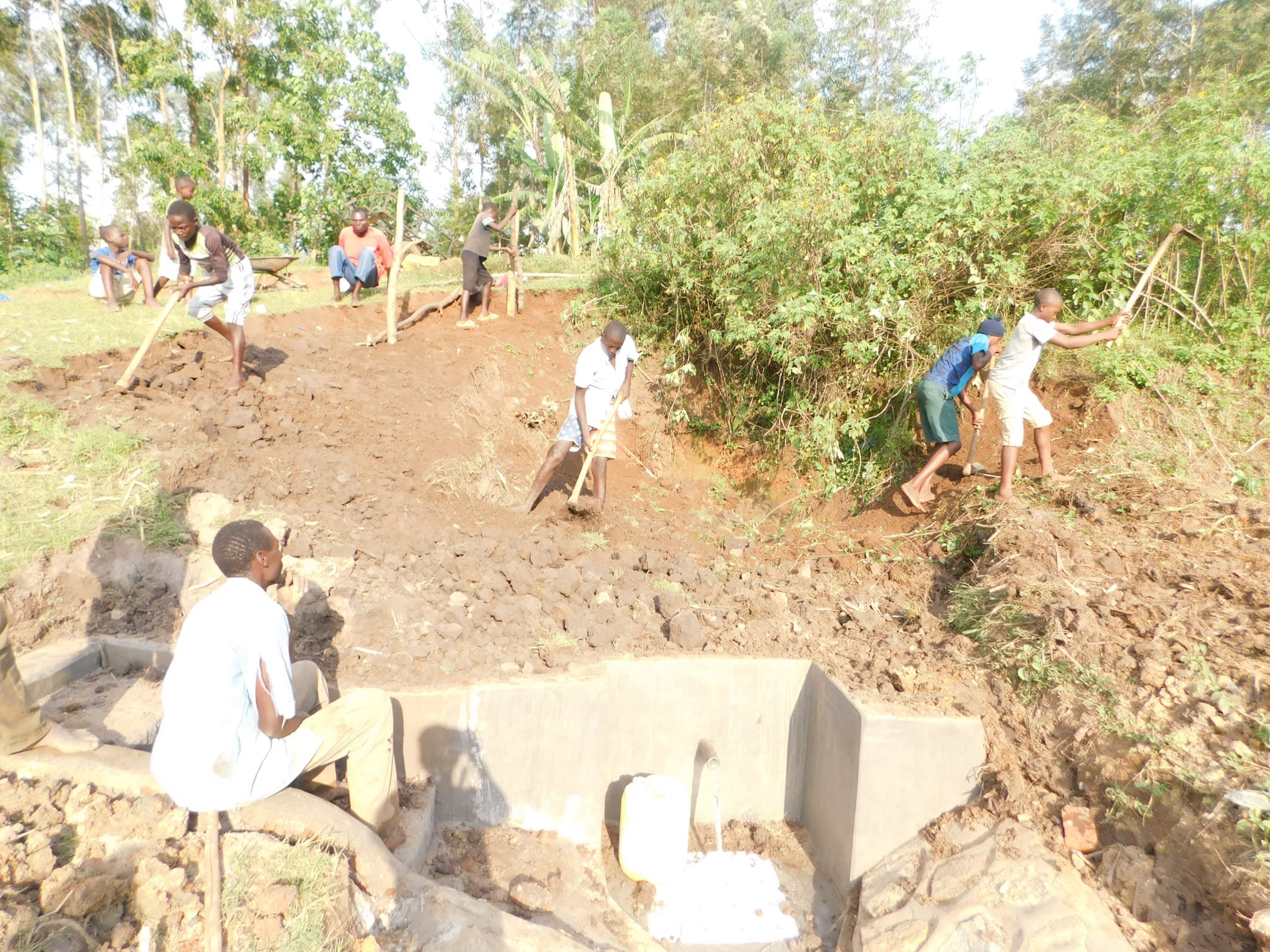Please note: original photos were taken before the COVID-19 pandemic.
Though Namukuru Spring serves 600 people including those who attend church at the nearby Anglican Church of Kenya, its water is far from desirable.
During the rainy season when it rains heavily, the spring water gets contaminated by soil washed directly into the spring. To ease access, community members have tried to improvise a discharge pipe using a plastic jug lodged into the earth. But the jug inevitably comes loose, gets dirty, and misses out on some of the spring's discharge on either side of its opening. To reach the jug, people must step into the water that pools below it, exposing themselves to dangerous insects that bite them if they delay inside the water.
Because the spring has never dried up, people are not the only ones who rely on its water. The spring also attracts all sorts of animals like cats, dogs, and rodents which contaminate the area and the water. Furthermore, the spring is surrounded by bushes that harbor more dangerous insects and snakes. These are especially concerning for the many children who are sent to the spring by parents to help with household responsibilities.
The community reports frequent cases of diarrhea in the young and old alike. They attribute these illnesses to drinking the dirty spring water.
"I have severally suffered from diarrhea even in the last 1 week. I had gone to hospital because of the same; this is because we drink this water the way it is and it's open - anything can drink it directly - and we still fetch it," said 58-year-old farmer Loyce Wachiya.
"I do suffer from stomachache whenever I take this water because it's not clean or safe for drinking," added a young Sharmil.
What We Can Do:
Spring Protection
Protecting the spring will help provide access to cleaner and safer water and reduce the time people have to spend to fetch it. Construction will keep surface runoff and other contaminants out of the water. With the community’s high involvement in the process, there should be a good sense of responsibility and ownership for the new clean water source.
Fetching water is a task predominantly carried out by women and young girls. Protecting the spring and offering training and support will, therefore, help empower the female members of the community by freeing up more of their time and energy to engage and invest in income-generating activities and their education.
Training on Health, Hygiene, COVID-19, and More
To hold trainings during the pandemic, we work closely with both community leaders and the local government to approve small groups to attend training. We ask community leaders to invite a select yet representative group of people to attend training who will then act as ambassadors to the rest of the community to share what they learn. We also communicate our expectations of physical distancing and wearing masks for all who choose to attend.
The training will focus on improved hygiene, health, and sanitation habits in this community. We will also have a dedicated session on COVID-19 symptoms, transmission routes, and prevention best practices.
With the community’s input, we will identify key leverage points where they can alter their practices at the personal, household, and community levels to affect change. This training will help to ensure participants have the knowledge they need about healthy practices and their importance to make the most of their water point as soon as water is flowing.
Our team of facilitators will use a variety of methods to train community members. Some of these methods include participatory hygiene and sanitation transformation, asset-based community development, group discussions, handouts, and demonstrations at the spring.
One of the most important issues we plan to cover is the handling, storage, and treatment of water. Having a clean water source will be extremely helpful, but it is useless if water gets contaminated by the time it is consumed. We and the community strongly believe that all of these components will work together to improve living standards here, which will help to unlock the potential for these community members to live better, healthier lives.
We will then conduct a small series of follow-up trainings before transitioning to our regularly scheduled support visits throughout the year.
Training will result in the formation of a water user committee, elected by their peers, that will oversee the operations and maintenance of the spring. The committee will enforce proper behavior around the spring and delegate tasks that will help preserve the site, such as building a fence and digging proper drainage channels. The fence will keep out destructive animals and unwanted waste, and the drainage will keep the area’s mosquito population at a minimum.

 Protected Spring
Protected Spring
 Rehabilitation Project
Rehabilitation Project




































